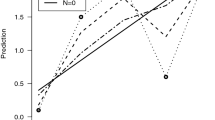Abstract
Consider the problem of discriminating between two rival response surface models and estimating parameters in the identified model. To construct designs serving for both model discrimination and parameter estimation, the M γ-optimality criterion, which puts weight γ (0≤γ≤1) for model discrimination and 1 − γ for parameter estimation, is adopted. The corresponding M γ-optimal product design is explicitly derived in terms of canonical moments. With the application of the maximin principle on the M γ-efficiency of any M γ'-optimal product design, a criterion-robust optimal product design is proposed.
Similar content being viewed by others
References
Atkinson AC (1972) Planning experiments to detect inadequate regression models. Biometrika 59: 275–293
Atkinson AC (1981) A comparison of two criteria for the design of experiments for discriminating between models. Technometrics 23: 301–305
Atkinson AC, Cox DR (1974) Planning experiments for discriminating between models (with discussion). J R Stat Soc Ser B 36: 321–348
Atkinson AC, Fedorov VV (1975a) The design of experiments for discriminating between two rival models. Biometrika 62: 57–70
Atkinson AC, Fedorov VV (1975b) Optimal design: experiments for discriminating between several models. Biometrika 62: 289–303
Biswas A, Chaudhuri P (2002) An efficient design for model discrimination and parameter estimation. Biometrika 89: 709–718
Box GEP, Hill WJ (1967) Discrimination among mechanistic models. Technometrics 9: 57–71
Dette H (1993) On a mixture of the D- and D 1-optimality criterion in polynomial regression. J Stat Plan Inference 35: 233–249
Dette H (1994) Discrimination designs for polynomial regression on compact intervals. Ann Stat 22: 890–903
Dette H (1995) Optimal designs for identifying the degree of a polynomial regression. Ann Stat 23: 1248–1266
Dette H, Franke T (2000) Constrained D- and D 1-optimal designs for polynomial regression. Ann Stat 28: 1702–1727
Dette H, Franke T (2001) Robust designs for polynomial regression by maximizing a minimum of D- and D 1-efficiencies. Ann Stat 29: 1024–1049
Dette H, Haller G (1998) Optimal designs for the identification of the order of a Fourier regression. Ann Stat 26: 1496–1521
Dette H, Kwiecien R (2004) A comparison of sequential and non-sequential designs for discrimination between nested regression models. Biometrika 91: 165–176
Dette H, Röder I (1997) Optimal discrimination designs for multifactor experiments. Ann Stat 25: 1161–1175
Dette H, Studden WJ (1997) The theory of canonical moments with applications in statistics, probability, and analysis. Wiley, New York
Hill PDH (1978) A review of experimental design procedures for regression model discrimination. Technometrics 20: 15–24
Hunter WG, Reiner AM (1965) Designs for discriminating between two rival models. Technometrics 7: 307–323
Lau TS (1983) Theory of canonical moments and its application in polynomial regression, I and II. Technical Reports 83-23 and 83-24, Department of Statistics, Purdue University
Lau TS (1988) D-optimal designs on the unit q-ball. J Stat Plan Inference 19: 299–315
Läuter E (1974) Experimental design in a class of models. Math Oper Stat 5: 379–398
Lim YB, Studden WJ (1988) Efficient D s -optimal designs for multivariate polynomial regression on the q-cube. Ann Stat 16: 1225–1240
Meeter D, Pine W, Blot W (1970) A comparison of two model-discrimination criteria. Technometrics 12: 457–470
Pukelsheim F (1993) Optimal design of experiments. Wiley, New York
Pukelsheim F, Rosenberger JL (1993) Experimental designs for model discrimination. J Am Stat Assoc 88: 642–649
Skibinsky M (1967) The range of the (n + 1)-th moment for distributions on [0,1]. J Appl Probab 4: 543–552
Skibinsky M (1986) Principal representations and canonical moment sequences for distribution on an interval. J Math Anal Appl 120: 95–120
Spruill C (1990) Good designs for testing the degree of a polynomial mean. Sankhya Ser B 52: 67–74
Studden WJ (1982) Some robust-type D-optimal designs in polynomial regression. J Am Stat Assoc 77: 916–921
Tsai MH, Zen MM (2004) Criterion-robust optimal designs for model discrimination and parameter estimation: multivariate polynomial regression case. Stat Sin 14: 591–601
Zen MM, Tsai MH (2002) Some criterion-robust optimal designs for the dual problem of model discrimination and parameter estimation. Sankhya Ser B 64: 322–338
Author information
Authors and Affiliations
Corresponding author
Rights and permissions
About this article
Cite this article
Tsai, MH. Criterion-robust optimal product designs for discrimination between nested response surface models. Metrika 70, 355–367 (2009). https://doi.org/10.1007/s00184-008-0196-1
Received:
Published:
Issue Date:
DOI: https://doi.org/10.1007/s00184-008-0196-1



